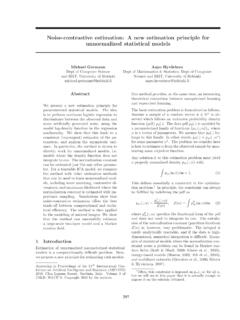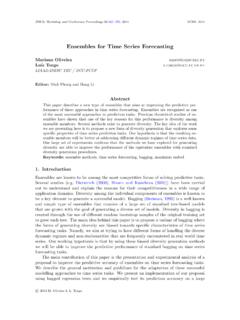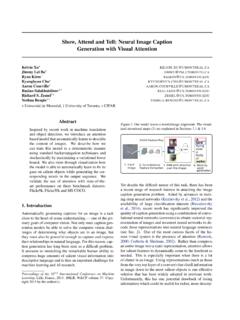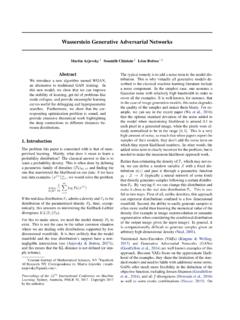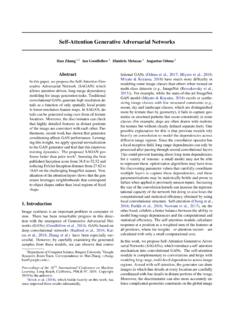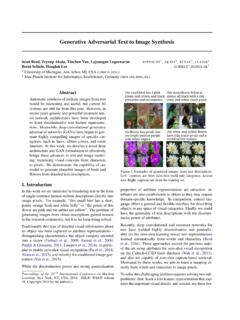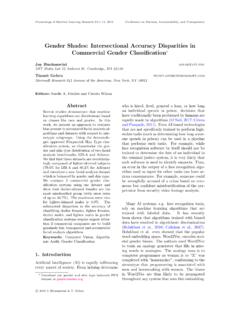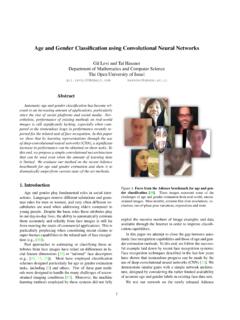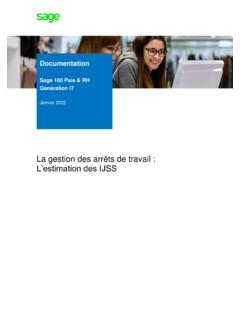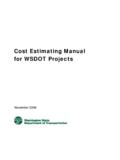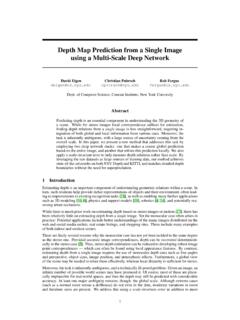Transcription of Dropout as a Bayesian Approximation: Representing Model …
1 Dropout as a Bayesian Approximation: Representing Model uncertainty in Deep LearningYarin of CambridgeAbstractDeep learning tools have gained tremendous at-tention in applied machine learning. Howeversuch tools for regression and classification donot capture Model compari-son, Bayesian models offer a mathematicallygrounded framework to reason about Model un-certainty, but usually come with a prohibitivecomputational cost. In this paper we develop anew theoretical framework casting Dropout train-ing in deep neural networks (NNs) as approxi-mate Bayesian inference in deep Gaussian pro-cesses.
2 A direct result of this theory gives ustools to Model uncertainty with Dropout NNs extracting information from existing models thathas been thrown away so far. This mitigatesthe problem of Representing uncertainty in deeplearning without sacrificing either computationalcomplexity or test accuracy. We perform an ex-tensive study of the properties of Dropout s un-certainty. Various network architectures and non-linearities are assessed on tasks of regressionand classification, using MNIST as an show a considerable improvement in predic-tive log-likelihood and RMSE compared to ex-isting state-of-the-art methods, and finish by us-ing Dropout s uncertainty in deep IntroductionDeep learning has attracted tremendous attention from re-searchers in fields such as physics, biology, and manufac-turing, to name a few (Baldi et al.)
3 , 2014; Anjos et al., 2015;Bergmann et al., 2014). Tools such as neural networks(NNs), Dropout , convolutional neural networks (convnets),and others are used extensively. However, these are fields inwhich Representing Model uncertainty is of crucial impor-tance (Krzywinski & Altman, 2013; Ghahramani, 2015).With the recent shift in many of these fields towards the useof Bayesian uncertainty (Herzog & Ostwald, 2013; Trafi-Proceedings of the33rdInternational Conference on MachineLearning, New York, NY, USA, 2016. JMLR: W&CP volume48. Copyright 2016 by the author(s).mow & Marks, 2015; Nuzzo, 2014), new needs arise fromdeep learning deep learning tools for regression and classifica-tion do not capture Model uncertainty .
4 In classification,predictive probabilities obtained at the end of the pipeline(the softmax output) are often erroneously interpreted asmodel confidence. A Model can be uncertain in its predic-tions even with a high softmax output (fig. 1). Passing apoint estimate of a function (solid line 1a) through a soft-max (solid line 1b) results in extrapolations with unjustifiedhigh confidence for points far from the training forexample would be classified as class 1 with , passing the distribution (shaded area 1a) througha softmax (shaded area 1b) better reflects classification un-certainty far from the training uncertainty is indispensable for the deep learningpractitioner as well.
5 With Model confidence at hand we cantreat uncertain inputs and special cases explicitly. For ex-ample, in the case of classification, a Model might return aresult with high uncertainty . In this case we might decideto pass the input to a human for classification. This canhappen in a post office, sorting letters according to their zipcode, or in a nuclear power plant with a system responsi-ble for critical infrastructure (Linda et al., 2009). Uncer-tainty is important in reinforcement learning (RL) as well(Szepesv ari, 2010). With uncertainty information an agentcan decide when to exploit and when to explore its envi-ronment.
6 Recent advances in RL have made use of NNs forQ-value function approximation. These are functions thatestimate the quality of different actions an agent can greedy search is often used where the agent selectsits best action with some probability and explores other-wise. With uncertainty estimates over the agent s Q-valuefunction, techniques such as Thompson sampling (Thomp-son, 1933) can be used to learn much probability theory offers us mathematicallygrounded tools to reason about Model uncertainty , but theseusually come with a prohibitive computational cost. It isperhaps surprising then that it is possible to cast recentdeep learning tools as Bayesian models without chang-ing either the models or the optimisation.
7 We show thatthe use of Dropout (and its variants) in NNs can be inter-preted as a Bayesian approximation of a well known prob- Dropout as a Bayesian Approximation: Representing Model uncertainty in Deep Learning(a) Arbitrary functionf(x)as a function of datax(softmaxinput)(b) (f(x))as a function of datax(softmaxoutput)Figure sketch of softmax input and output for an idealised binary classification data is given between thedashed grey lines. Function point estimate is shown with a solid line. Function uncertainty is shown with a shaded area. Marked with adashed red line is a pointx far from the training data. Ignoring function uncertainty , pointx is classified as class 1 with Model : the Gaussian process (GP) (Rasmussen &Williams, 2006).
8 Dropout is used in many models in deeplearning as a way to avoid over-fitting (Srivastava et al.,2014), and our interpretation suggests that Dropout approx-imately integrates over the models weights. We developtools for Representing Model uncertainty of existing dropoutNNs extracting information that has been thrown away sofar. This mitigates the problem of Representing Model un-certainty in deep learning without sacrificing either compu-tational complexity or test this paper we give a complete theoretical treatment ofthe link between Gaussian processes and Dropout , and de-velop the tools necessary to represent uncertainty in deeplearning.
9 We perform an extensive exploratory assessmentof the properties of the uncertainty obtained from dropoutNNs and convnets on the tasks of regression and classifi-cation. We compare the uncertainty obtained from differ-ent Model architectures and non-linearities in regression,and show that Model uncertainty is indispensable for clas-sification tasks, using MNIST as a concrete example. Wethen show a considerable improvement in predictive log-likelihood and RMSE compared to existing state-of-the-art methods. Lastly we give a quantitative assessment ofmodel uncertainty in the setting of reinforcement learning,on a practical task similar to that used in deep reinforce-ment learning (Mnih et al.)
10 , 2015).12. Related ResearchIt has long been known that infinitely wide (single hid-den layer) NNs with distributions placed over their weightsconverge to Gaussian processes (Neal, 1995; Williams,1997). This known relation is through a limit argument thatdoes not allow us to translate properties from the Gaus-sian process to finite NNs easily. Finite NNs with distri-butions placed over the weights have been studied exten-sively asBayesian neural networks(Neal, 1995; MacKay,1992). These offer robustness to over-fitting as well, butwith challenging inference and additional computationalcosts. Variational inference has been applied to these mod-els, but with limited success (Hinton & Van Camp, 1993;1 Code and demos are available & Bishop, 1998; Graves, 2011).
